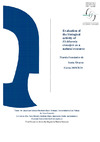Identificador persistente para citar o vincular este elemento:
https://accedacris.ulpgc.es/handle/10553/74395
| Campo DC | Valor | idioma |
|---|---|---|
| dc.contributor.advisor | Gómez Pinchetti, Juan Luis | es |
| dc.contributor.advisor | Morales Rodrigo, Sara | es |
| dc.contributor.author | Fernández De Soria Álvarez, Marcia | es |
| dc.date.accessioned | 2020-09-15T10:47:00Z | - |
| dc.date.available | 2020-09-15T10:47:00Z | - |
| dc.date.issued | 2020 | - |
| dc.identifier.uri | https://accedacris.ulpgc.es/handle/10553/74395 | - |
| dc.description.abstract | Keeping in mind to contribute to the well-being and development through the use of natural resources, the following document has been developed. The objective of the present study was determine the possible use of water hyacinth (E.crassipes) from the Guadiana river as a natural resource after its massive extraction from river basins in which it is considered an invasive plant. Laboratory experiments were carried out to quantify the biomass parameters, following official method, in E.crassipes to be used as animal feed, as well as its potential as component of growth medium for fungi. In addition, the amount of total polyphenol content and the total antioxidant capacity were determined after four different extraction methods. Eichhornia crassipes composition was characterized by low protein and ash values (8% and 1.31% respectively), and high values of NDF (59.97%) and ADF (26.61%). It was determined, that the most effective method for the extraction of total polyphenol content was boiling the biomass prior to filtration, and in the case of antioxidant activity, this parameter was the highest after ethanolic extraction of the dry biomass. Using dry E. crassipes biomass as a component of the growth medium for fungi under laboratory conditions resulted in a higher growth promotion when compared with commercial PDA. | en_US |
| dc.language | eng | en_US |
| dc.subject | 2417 Biología vegetal (botánica) | en_US |
| dc.subject.other | Growth media | es |
| dc.subject.other | Antioxidant activity | es |
| dc.subject.other | Phenolic content | es |
| dc.subject.other | Aquatic weed | es |
| dc.subject.other | Proximal composition | es |
| dc.title | Evaluation of the biological activity of Eichhornia crassipes as a natural resource | es |
| dc.type | info:eu-repo/semantics/bachelorThesis | en_US |
| dc.type | BachelorThesis | en_US |
| dc.contributor.departamento | Departamento de Biología | es |
| dc.contributor.facultad | Facultad de Ciencias del Mar | en_US |
| dc.investigacion | Ciencias | en_US |
| dc.type2 | Trabajo final de grado | en_US |
| dc.utils.revision | Sí | en_US |
| dc.identifier.matricula | TFT-57187 | es |
| dc.identifier.ulpgc | Sí | en_US |
| dc.contributor.buulpgc | BU-BAS | es |
| dc.contributor.titulacion | Grado en Ciencias del Mar | es |
| item.fulltext | Con texto completo | - |
| item.grantfulltext | restricted | - |
| crisitem.advisor.dept | GIR IOCAG: Oceanografía Biológica y Algología Aplicada | - |
| crisitem.advisor.dept | IU de Oceanografía y Cambio Global | - |
| crisitem.advisor.dept | Departamento de Biología | - |
| Colección: | Trabajo final de grado Restringido ULPGC | |
Visitas
349
actualizado el 10-ago-2024
Descargas
38
actualizado el 10-ago-2024
Google ScholarTM
Verifica
Comparte
Exporta metadatos
Los elementos en ULPGC accedaCRIS están protegidos por derechos de autor con todos los derechos reservados, a menos que se indique lo contrario.
